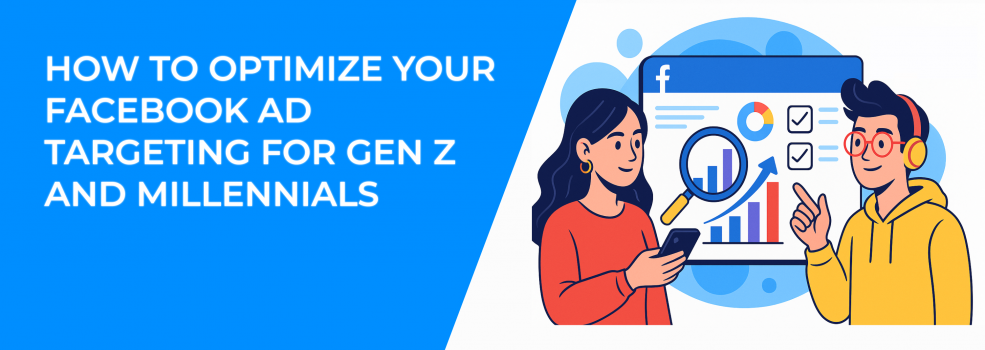If your Facebook ads still sound like they were written a decade ago, Gen Z has probably already scrolled past. And Millennials? They’re more likely to click on your competitor’s post instead. Reaching these audiences in 2025 isn’t just about knowing their age or picking a few interests. It’s about understanding how they think, what they do online, and what makes them pause and pay attention.
So how can you adjust your ad strategy to better connect with these two fast-moving, digital-first generations?
Let’s break it down.
1. Understand Who They Really Are
Don’t rely on vague labels. Yes, both generations spend time online — but so does everyone else. What matters more is how they use social media and why.
Gen Z (ages 10–27) wants things to feel honest and quick. They care about realness and can spot ads trying too hard. They may prefer platforms like TikTok, but many still use Instagram and Facebook for things like groups, events, and shared interests.
Millennials (ages 28–44) are more patient. They scroll with purpose. They look for brands that reflect their values and respond well to clear, thoughtful content. Facebook and Instagram are still part of their daily routine.
If you're targeting both generations the same way, you're probably missing what really matters to each.
2. Use Behavioral and Life Stage Signals
Just knowing someone’s age isn’t enough. A better way to connect is by focusing on what’s happening in their life right now.
Are they starting a new job? Having a child? Working remotely? Moving to a new city?
Facebook lets you target based on these changes. For example:
-
Job or relocation: Target Millennials moving to a new home or starting a new role.
-
School and education: Reach Gen Z college students with content that speaks to where they’re headed.
-
Travel patterns: Use travel behavior to show relevant products or services at the right time.
These details can change how your ad feels to someone. A Gen Z college student isn’t looking for the same thing as a young entrepreneur, even if they’re the same age.
Want to get more out of Facebook’s behavioral targeting? Here’s a detailed breakdown of how to use life events and behaviors effectively.
3. Refine Interests with Precision, Then Test Broad
One common mistake is narrowing your audience too much. Facebook’s targeting tools have changed, and interest-based filters aren’t as sharp as they used to be. But they can still work — with the right setup.
Try starting with just a couple of well-matched interests and build from there. Create lookalike audiences based on your best-performing customers. Then test a broader campaign using Advantage+ targeting to let Facebook find new matches.
Here’s something to try: What happens when you remove your assumptions and rely only on performance data? Run one ad set with tight targeting and another with a broader reach. Compare results and see what’s working.
4. Speak Their Language — Creatively and Contextually
Once you’ve found the right audience, how do you get their attention?
Gen Z responds to content that feels casual and native to the platform. Think memes, short videos, and a relaxed tone. But don’t try to mimic their style too closely — it can come off as fake.
Millennials usually prefer well-designed posts with clear messages — especially when the story or tone feels thoughtful. A strong idea often works better than a hard sell.
Test different types of creatives for each group.
For Gen Z, consider:
-
Vertical videos that look like they were made on a phone,
-
Bold text with simple visuals,
-
Humor or trending sound clips (especially from Instagram Reels).
For ideas on short-form content that feels native to Gen Z, check out this guide to using Instagram Reels in your strategy.
For Millennials, try:
-
Carousels that explain a product or service step-by-step,
-
Messages that highlight values or long-term benefits,
-
Social proof, like reviews or customer feedback.
Keep things accessible — use subtitles, clear fonts, and layouts that make sense on a small screen.
5. Think Mobile-First, But Not Just Mobile
Both generations use phones a lot — but that doesn’t mean they make every decision there.
Millennials might see your ad during a break at work, then return later on a laptop. Gen Z might save your post or share it with a friend before coming back to it.
Design your customer journey with this in mind. Use retargeting to connect across devices. Make sure your website or landing page loads fast and works well everywhere — or people will move on.
Also, consider changing your message slightly as people get more familiar with your brand. You can start with a simple intro, then follow up with more detail or a stronger offer as they keep interacting.
6. Retarget With Relevance — Not Repetition
Many advertisers get this wrong. Retargeting isn’t just about reminding people. It should give them a reason to take another look.
For Gen Z, you might want to switch formats completely. Show them a behind-the-scenes clip, a different product, or a post that highlights your style or values.
For Millennials, use retargeting to add useful info — like reviews, guarantees, or a limited-time offer. If they didn’t buy the first time, maybe they just had questions.
Tip: use dynamic creative or Advantage+ Creative to automatically rotate different messages, images, and calls to action. This helps keep your ads fresh, even for people who’ve seen them before.
If you're new to retargeting or need to clean up your setup, here’s a practical guide on how to set up Facebook retargeting that walks through the steps.
7. Use Analytics to Spot the Breaks in the Funnel
Don’t just track clicks or purchases. Look at the full picture. Are Gen Z users showing interest but not buying? Are Millennials adding to cart but not checking out?
Use your ad manager to break the data down by age, device, and placement. If people are getting stuck somewhere, make small changes and test again.
The more you understand how each group interacts with your ads, the better you can shape your targeting.
Final Thoughts
To reach Gen Z and Millennials with Facebook ads, you don’t need trendy slang or flashy tricks. You need to pay attention to what matters to them, create content that fits how they browse, and show up when it counts.
As platforms shift and targeting tools evolve, the smartest approach is to stay flexible, keep learning, and test often.
Because the more relevant your message, the better your results. Always.

